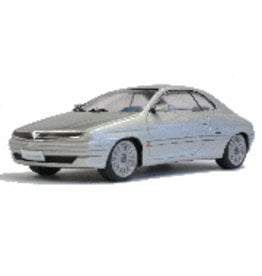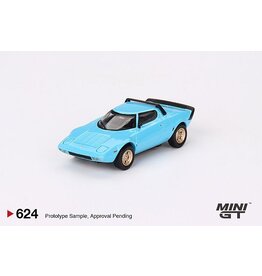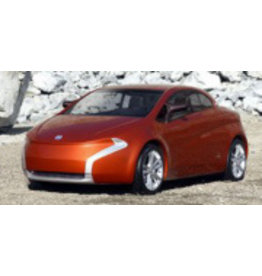LANCIA by BERTONE
By 1970, Bertone had a workforce of 1,500 staff, and the Grugliasco factory covered an area of 267,000 square metres (2,870,000 sq ft). The partnership with Lamborghini led to the development of the Lamborghini Espada, by 1973 known as the world's fastest four-seater. The design was inspired by an earlier concept, the Jaguar Pirana. After his initial success with the Espada, he went on to design the Lamborghini Jarama and the Lamborghini Urraco. With the Stratos Zero prototype, which was built on a Lancia Fulvia 1.6 HF base, Bertone came to represent a new point of reference in modern art, as well as on the international car design scene. The Stratos Zero, which was presented at the 1970 Turin Motor Show, evoked a timeless blend of architecture, sculpture, and industrial design. The following year, with some of the Zero's styling cues as a starting point, Bertone created the Lancia Stratos Stradale, a compact coupé destined mainly for the racing circuit, and which went on to win numerous victories in world rally championships.
In 1972, Giovanni Bertone died. In that year, as a tacit tribute to the company's founder, the Maserati Khamsin and the Fiat X1/9 were released. The latter, foreshadowed by the Autobianchi A112 Runabout concept car, was the heir of the 850 Spider and went on to enjoy the same runaway commercial success. Based on the Fiat 128 chassis but with a mid-rear-engine layout, the X1/9 was in production from 1972 to 1988, with 160,000 units manufactured.
Meanwhile, Marcello Gandini's prolific drawing board saw a succession of supercars, runabouts, and provocative style concepts. These included the 1973 Series 3 version of the Lamborghini Espada, which redesigned the dashboard configuration, the Lamborghini Countach and the Ferrari 308 GT4 of 1973, the Audi 50 and Innocenti Mini 90 of 1974, the Fiat 131 Abarth Rally in 1975, and the prototype Alfa Romeo Navajo in 1976.
In the same year, the company began working for Volvo on the 264 TE. The Volvo 262C, which was presented at the 1977 Geneva Motor Show, was entirely manufactured by Bertone, from the assembly of the basic body to the fitting of the mechanical components and the road trials. This procedural turning point had a big role in transforming the company, which was now set to become a car manufacturer in its own right.
- AB VOLVO
- AC CARS
- ACADIAN
- ACURA
- ADLER
- AEC
- ALFA ROMEO
- ALFA ROMEO BY ABARTH
- ALFA ROMEO BY BERTONE
- ALFA ROMEO BY CARROZZERIA TOURING
- ALFA ROMEO BY CASTAGNA
- ALFA ROMEO BY COLLI CAROZZERIA
- ALFA ROMEO BY GHIA
- ALFA ROMEO By ITALDESIGN
- ALFA ROMEO by OSI
- ALFA ROMEO by PININFARINA
- ALFA ROMEO BY TOURING
- ALFA ROMEO by VIGNALE
- ALFA ROMEO BY ZAGATO
- ALLARD MOTOR COMPANY LIMITED
- ALPINE(SOCIETE DESAUTOMOBILES ALPINE SAS)
- ALVIS
- ALVIS BY VANDEN PLAS
- AMC(American Motor Company)
- AMILCAR
- AMILCAR by LA PHOCEENNE
- APRILIA
- Argo Racing Cars Ltd.
- ARMSTRONG WITHWORTH AIRPLANE COMPANY
- ART & TECH STUDIO
- ASA (Autocostruzioni Società per Azioni)
- ASTON MARTIN
- ASTON MARTIN by BERTONE
- ASTON MARTIN by BONIOLO
- ASTON MARTIN BY GRABER
- ASTON MARTIN by ITALDESIGN
- ASTON MARTIN by OGLE
- ASTON MARTIN BY VIGNALE
- ASTON MARTIN by ZAGATO
- ASTON MARTIN LAGONDA BY VIGNALE
- ASTON MARTIN LAGONDA LIMITED
- ATELIER DE CONSTRUCTION ROANNE
- ATKINSON VEHICLES LIMITED
- AUBURN AUTOMOBILE COMPANY
- AUBURN BY BEUHRIG
- AUDI
- AUDI BY DARWINPRO
- AUDI by PININFARINA
- AUSTIN MOTOR COMPANY Ltd.
- AUSTRO-DAIMLER
- AUSTRO-DAIMLER by KEIBL
- AUTOBIANCHI
- AUTOBIANCHI BY BERTONE
- AUTOBIANCHI BY PININFARINA
- AUTOBIANCHI BY ZAGATO
- AUTOMOBILI LAMBORGHINI S.p.A.
- AUTOMOBILI LAMBORGHINI SpA by CHRYSLER
- AUTOMOBILI LAMBORGHINI BY LB WORKS
- AUTO UNION
- AVIA MOTORS S.R.O.
- AVRO
- AvtoKuban
- BAE Systems AB
- BAJAJ
- BARKAS(VEB Barkas-Werke)
- BARREIROS DIESEL S.A.
- BAUER CARROSSERIE
- BAW International - Beijing Automobile Works Co., Ltd.
- BEDFORD
- BelAZ
- BELL
- BENELLI
- BENTLEY
- BENTLEY by ABBOTT
- BENTLEY by FRANAY
- BENTLEY by GRABER
- BENTLEY by MULLINER
- BENTLEY BY PININFARINA
- BENTLEY BY WENDLER
- BERLIET
- BERTONE
- BETA MOTORCYCLES
- BMC(The British Motor Corporation LTD)
- BMW
- BMW BY ALPINA
- BMW by Bertone
- BMW by DarwinPRO
- BMW by FRUA
- BMW by ITALDESIGN
- BMW BY LIBERTY WORKS
- BMW by PININFARINA
- BMW by ZAGATO
- BORGWARD
- BRISTOL CARS LIMITED
- BRITISH LEYLAND
- BRM(British Racing Motors)
- BUGATTI
- BUGATTI BY BERTELLI
- BUGATTI by VANDENPLAS
- BÜHRER TRAKTORENFABRIK AG.
- BUICK
- BUICK BY LANCEFIELD
- BUICK by PININFARINA
- BÜSSING AG
- CADILLAC(GENERAL MOTORS)
- Cadillac by ASC
- Cadillac by Derham.
- CADILLAC by EUREKA & Co.
- Cadillac by Fleetwood
- CADILLAC BY MILLER-METEOR
- CADILLAC BY PININFARINA
- CADILLAC by SUPERIOR COACH CORPORATION
- CAGIVA
- CANADIAN MILITARY PATTERN(CHEVROLET)
- CATERHAM CARS
- CATERPILLAR
- CHECKER MOTORS CORPORATION
- CHENARD & WALCKER
- CHEVROLET
- CHEVROLET BY AMERICAN CUSTOM COACHWORKS.
- Chevrolet by Bertone
- CHEVROLET by PININFARINA
- CHEVRON CARS
- CHRYSLER
- CHRYSLER BY GHIA
- ChTZ(Chelyabinsk Tractor Plant)
- CIMATTI
- CISITALIA by PININ FARINA
- CISITALIA BY PININFARINA OR VIGNALE
- CISITALIA by STABILIMENTI FARINA
- Citroën
- CITROËN by BERTONE
- Citroën by H.Chapron
- CITROËN by PININFARINA
- CIZETA-MORODOR
- COMMER
- CONDOR-WERKE AG
- CORD
- CORD BY HAYES BODY COMPANY
- COURAGE COMPETITION
- CROSLEY CORPORATION
- DACIA
- DAF
- DAIHATSU MOTOR Co.Ltd.
- DAIMLER(D)
- DAIMLER(UK)
- DAIMLER BY WILCOX
- Dallara Group S.r.l.
- DATSUN
- DB PANHARD
- DE HAVILLAND
- DE HAVILLAND BY MORRIS MOTOR COMPANY
- DELAGE(SAFAD)
- DELAGE BY AUTOBINEAU
- DELAGE by H.CHAPRON
- DELAGE FERNANDEZ & DARRIN
- DELAGE BY LETOURNEUR & MARCHAND
- DELAGE by PARTOUT
- DELAHAYE
- DELAHAYE BY CHAPRON
- DELAHAYE BY FIGONI & FALASCHI
- DELAHAYE BY GILLORE
- DELPHI INDY CAR
- Demm Motorcycles (Spa Officine Meccaniche Fratelli Daldi & Matteucci, Porretta Terme)
- Dennis Brothers LTD
- DENZEL AUTOMOBILE COMPANY
- DESOTO(CHRYSLER)
- DE TOMASO
- DE TOMASO by GHIA
- DE TOMASO by FISSORE
- DEUTSCH-BONNET(Panhard engine)
- DEUTZ-FAHR
- DEVON MOTORWORKS
- DIAMOND T
- DIFFERENT CAR MODELS
- DISNEY
- DKW
- DODGE(CHRYSLER)
- DODGE BY GHIA
- DOME Co.LTD
- Dongfeng Peugeot-Citroën Automobile Co., Ltd.
- DONKERVOORT AUTOMOBIELEN BV
- Dr.-Ing.Ulrich ESTERER GmbH & Co.KG.png
- DUCATI MOTOR COMPANY S.p.A.
- DUCKHAMS COSWORTH
- DUESENBERG
- DUESENBERG BY BOHMAN & SCHWARTZ
- DUESENBERG BY D'IETEREN
- DUESENBERG BY FIGONI
- DUESENBERG BY G.NUTTING
- DUESENBERG BY LAGRANDE
- DUESENBERG BY MURPHY
- DUESENBERG BY ROLLSON/ROLLSTON
- DUPLE COACHBUILDERS
- DV BUS & COACH
- DZERZHINSKY PLANT KIEV
- EBRO
- EDONIS
- EDSEL
- Eidgenössische Konstruktionswerkstätte
- EMW(Eisenacher Motorenwerk)
- ENFIELD
- ERF
- ERICH BITTER AUTOMODELS GmbH(BITTER)
- EUROCOPTER GROUP
- Fábrica de Automotores Utilitarios SAICF
- FACEL S.A.
- FARIZON(GEELY)
- FAW Toyota Motor Co.
- FAW-VOLKSWAGEN
- FBW(Franz Brozincevic Wetzikon)
- FENDT
- FERRARI S.p.A.
- FERRARI BY BERTONE
- FERRARI by CASTAGNA
- FERRARI BY GHIA
- FERRARI BY DROGO CARROZZERIA SPORTS CAR
- FERRARI BY MICHELOTTI
- FERRARI by MODENA DESIGN
- FERRARI BY PININFARINA
- FERRARI BY SCAGLIETTI
- FERRARI by STABILIMENTI FARINA
- FERRARI BY TOURING
- FERRARI BY VIGNALE
- FERRARI BY ZAGATO
- FFA(Flug-und Fahrzeug Werke Altenrhein)
- FIAT
- FIAT BY ABARTH
- FIAT BY BERTONE
- FIAT by CAPRERA
- FIAT BY CARROZZERIA ALFREDO VIGNALE
- FIAT by CORIASCO
- FIAT by FISSORE
- FIAT by ITALDESIGN
- FIAT BY LOMBARDI
- FIAT by PININFARINA
- FIAT BY ZAGATO
- FMC(Food Machinery Corporation)
- FODEN
- FORD BY COSWORTH
- FORD BY CRAYFORD
- FORD BY LOTUS
- FORD BY SHELBY
- FORD by ZAGATO
- FORD EUROPA
- FORDSON BY FORD MOTOR COMPANY
- FORD U.S.A.
- FORD by BERTONE
- FRAZER-NASH by GIUGIARO
- FREIGHTLINER(Daimler truck North America)
- FSO WARSZAWA
- GARELLI
- GAZ(Gorky Automobile Plant)
- GENERAL MOTORS
- GINETTA-FORD
- GMC
- GOGGOMOBIL/HANS GLAS GmbH
- GREAT WALL MOTOR
- GRIFFITH MOTOR COMPANY
- Guangzhou Xiaopeng Automotive Technology Automobile company
- Haas/Ferrari F1 Team
- HARLAND & WOLF
- HANOMAG
- HARLEY DAVIDSON
- HENDRICK MOTORSPORTS-NASCAR
- HEINKEL
- HENSCHEL & SON
- HHA(Hawker Hunter Aviation Ltd)
- HILLMAN BY ZAGATO
- HILLMAN MOTOR COMPANY
- HISPANO-SUIZA
- HISPANO-SUIZA BY FERNANDEZ & DARRIN
- HOLDEN(GENERAL MOTORS)
- HONDA by PININFARINA
- HONDA GIKEN KOGYO KABUSHIKI
- HONGQI
- HYMER CAMPERS
- HOMMELL
- HORCH
- HOTCHKISS ET CIE
- HRG ENGENIERING COMPANY
- HUDSON MOTOR CAR COMPANY
- HUMBER LIMITED
- HUMMER
- HÜRLIMANN
- HYUNDAI MOTOR COMPANY
- IAME(Industrias y Mecanicas del Estado IAME)
- IKARUS
- IMPERIAL(Chrysler)
- IMPERIAL(Crysler) BY GHIA
- IMPERIAL(Chrysler)BY LE BARON
- INNOCENTI
- INNOCENTI-LAMBRETTA
- INTERNATIONAL HARVESTER
- INVICTA BY CHARLESWORTH
- INVICTA BY TOURER
- ISO AUTOMOTOVEICOLA S.p.A.
- ISOBLOC
- ISO RIVOLTA
- ISOTTA FRASCHINI & Co
- ISOTTA FRACHINI by CASTAGNA
- ISOTTA FRASCHINI BY ZAGATO
- ITALJET
- IVECO
- ISUZU MOTORS Ltd
- JAGUAR
- JAGUAR BY BERTONE
- JAGUAR by FRUA
- JAGUAR BY GRABER
- JAGUAR BY VANDEN PLAS
- JAGUAR BY VICARAGE
- JAWA
- JEEP(FIAT CHRYSLER AUTOMOBILES)
- JENSEN MOTORS
- JETOUR
- Jiangling Motors Corporation Limited
- JLC
- JOE GIBBS RACING-NASCAR
- JUNKERS
- KAELBLE
- KAISER JEEP
- KAMAZ
- KAWASAKI
- KAZ(Kutaisi Auto Mechanical Plant)
- KENWORTH
- KhTZ(Karkivski Tractorni Zavod)
- KIEV ELECTRIC TRANSPORTATION PLANT
- KIROV ZAVOD
- KMZ(Kragnorsky Mechanical Works)
- KOENIGSEGG
- KÖPFLI
- KRAUSS MAFFEI
- KrAZ
- Gebakken. Krupp Motoren- und Kraftwagenfabriken GmbH
- KURGANMASHZAVOD
- LADA(AvtoVAZ)
- LAMBORGHINI by BERTONE
- LAMBORGHINI by ITALDESIGN
- LAMBORGHINI by PININFARINA
- LAMBORGHINI by STROSEK DESIGN GmbH & Co.KG
- LAMBORGHINI by ZAGATO
- LANCIA
- LANCIA BY ABARTH
- LANCIA by BERTONE
- LANCIA BY COLLI CAROZZERIA
- LANCIA by PININFARINA
- LANCIA BY ZAGATO
- LAND ROVER BY CUTHBERTSON
- LAND ROVER BY TICKFORD
- LAND ROVER(TATA MOTORS)
- LANZ
- LEA-FRANCIS
- LEXUS
- LEYLAND MOTORS
- LIAZ(Liderecké Avtomobilové Zavody)
- LIGIER AUTOMOBILES
- LINCOLN
- LINCOLN BY CARIBOU MOTOR COMPANY
- LOLA
- LOTUS
- MACK
- MAGIRUS-DEUTZ
- MALAGUTI
- MALANCA MOTORS SpA
- MALYSHEV FACTORY
- MAN
- MANIFATURA AUTOMOBIL TORINO
- MARCH ENGINEERING
- MARCOS ENGENIERING
- MARMON MOTOR COMPANY
- MASERATI
- MASERATI by ATL
- MASERATI BY BERTONE
- MASERATI BY CARROZZERIA FANTUZZI
- MASERATI by GHIA
- MASERATI by ITALDESIGN
- MASERATI BY PIETRO FRUA
- MASERATI by PININFARINA
- MASERATI by TOURING
- MASERATI BY ZAGATO
- MATRA
- MATRA SIMCA
- MAVERICK MOTORS
- MAYBACH(DAIMLER-BENZ)
- MAYBACH BY WAGNER-SPOHN
- MAZ(MINSK AUTOMOBILE PLANT)
- MAZDA by BERTONE
- MAZDA MOTOR CORPORATION
- MAZZANTI AUTOMOBILI
- McDonnell Douglas
- MCI(MOTOR COACH INDUSTRIES INTERNATIONAL INC.)
- McLAREN
- McLAREN HONDA F1 TEAM
- MEGATECH
- MELKUS
- MEMMINGER
- MENARDS RACING-NASCAR
- MENGERS Special Cars GmbH
- MERCEDES AMG PETRONAS F1 TEAM
- MERCEDES-BENZ
- MERCEDES BY AMG
- MERCEDES-BENZ AMG BY DARWINPRO
- MERCEDES BY ARMBRUSTER
- MERCEDES-BENZ BY CORSICA
- MERCEDES BY CRAYFORD.
- MERCEDES-BENZ BY GLÄSER KAROSSERIE
- MERCEDES-BENZ by MURPHY
- MERCEDES BY SAOUTCHIC
- MERCEDES BY WILCOX
- MERCURY(FORD MOTOR COMPANY)
- MESSERSCHMITT
- METAL MECANICA S.A.
- MEYERS MANX(VW engine)
- MINERVA by SAOUTCHIK
- MINERVA by VAN DEN PLAS
- MINI BY BMW
- MINI by RADFORD
- MG(SIAC)
- MG BY BERTONE
- MITSUBISHI MOTORS CORPORATION
- MONTESA-HONDA
- MONTEVERDI
- MORANE-SAULNIER
- MORGAN MOTOR COMPANY
- MORGAN OLSEN
- MORETTI MOTOR Co.
- MORRIS
- MORRIS BY ZAGATO
- MOTOBECANE
- MOTOBI
- MOTO GILERA S.p.A.
- MOTO GUZZI
- MOTOM
- MOTO MORINI
- MOTOR HOLDINGS
- MV AUGUSTA
- MZMA(Moskwitch)
- NAMI(Automotive Institute)
- NASH MOTOR COMPANY
- NAVISTAR INTERNATIONAL
- NEGRINI
- NEOPLAN
- NISSAN BY LIBERTY WALK
- NISSAN BY PANDEM
- NISSAN MOTORS
- NISSAN MOTORSPORT INTERNATIONAL Co.Ltd.
- NISSAN NISMO RACING TEAM
- NOBLA AUTOMOTIVE Ltd
- North American Aviation (NAA)
- Norton Motorcycle Company
- NSU
- OLDSMOBILE(GENERAL MOTORS)
- OM(Officine Meccaniche)
- Omohundro
- OPEL
- OPEL by BERTONE
- ORECA (Organisation Exploitation Compétition Automobiles)
- OSCA
- OSCA BY FISSORE
- OSCA by ZAGATO
- OSCAR MOTOR CYCLES
- OSELLA
- PACKARD
- PACKARD BY ABARTH
- PAGANI AUTOMOBILI S.p.A.
- PANHARD
- PANOZ
- PAZ(Pavlovo Bus Company)
- PEERLESS CARS Ltd.
- PEGASO
- PEGASO BY SAOUTCHIC
- PERIPOLI
- PETERBILT
- PEUGEOT
- PEUGEOT by PININFARINA
- PIAGGIO & C.SpA
- PIERCE ARROW
- PILATUS AIRCRAFT Ltd
- PLYMOUTH
- PONTIAC(GENERAL MOTORS)
- PORSCHE
- PORSCHE by BERTONE
- Porsche by Gemballa
- PORSCHE by PININFARINA
- PORSCHE BY RWB
- PORSCHE by TOP CAR DESIGN
- PORSCHE by ZAGATO
- PP SAUBER A.G.
- PRAGA
- PROTON HOLDINGS BERHAD
- PTMF
- PUBLIC/GILLET
- RAMBLER
- RAMSES AUTOMOBILES(NSU)
- RANGE ROVER BY HAMANN
- RAPID HOLDING Ltd
- R/C(RADIO CONTROL MODELS)
- RED BULL RACING
- RELIANT MOTORS
- RENAULT
- RENAULT BY GORDINI
- RENAULT SAMSUNG MOTORS
- REYNARD MOTORSPORT(Chrysler engine).
- RIGA CARRIAGE WORKS
- RIZATTA & C S.P.A
- ROCHET-SCHNEIDER
- ROLLS-ROYCE
- ROLLS-ROYCE BY BREWSTER & Co.
- ROLLS-ROYCE BY GHIA
- ROLLS-ROYCE BY HOOPER & Co.
- ROLLS ROYCE by LABOURDETTE
- ROLLS-ROYCE BY PARK WARD
- ROLLS-ROYCE BY PININFARINA
- ROLLS-ROYCE BY WILLOUGHBY
- ROMEO-MOTRON
- ROSENGART
- ROVER BY ZAGATO
- ROYAL AIRCRAFT ESTABLISHMENT(RAE)
- RUAG HOLDING Ltd
- RVR(Rigas Vagonbuves Rupnica)
- SAAB
- SAAB by BERTONE
- SAAB BY SIXTEN SASON
- SAIC-GM-Wuling Automobile
- Salmson
- SA MINERVA MOTORS
- SANTANA MOTOR
- SAURER UND BERNA
- SAVA(AUSTIN)
- SAVIEM
- SCANIA(VW AG)
- SCAMMEL LORRIES Ltd
- SCHLÜTER
- SCIMITAR BY BROOKS STEVENS
- Scuderia AlphaTauri
- SEAGRAVE FIRE APPARATUS
- SEAT BY ABARTH
- SETRA
- SHASTA TRAILER
- SHELBY
- SIATA(FIAT ENGINE)
- SIDES
- SIMCA
- SINGER VEHICLE DESIGN
- SMEAL-SPARTAN
- SOLEX
- SPADA VETTURE SPORT
- SPICE ENGINEERING
- SPYKER CARS
- SKODA AUTO
- SLOT CARS
- SLOT CAR FERRARI
- SMART
- SSC NORTH AMERICA
- STANGUELLINI
- STEYR-DAIMLER-PUCH
- STEYR WERKE AG
- SOCIEDAD ESPAGNOLA DE AUTOMOVICES DE TURISMO(SEAT).
- STUDEBAKER BROTHERS MANUFACTURING COMPANY.
- STUTZ
- STUTZ BY LANCEFIELD
- STUTZ BY OFFICINE PADANE S.p.A
- SUBARU
- SUD AVIATION
- SUNBEAM
- SUZUKI MOTOR CORPORATION
- SVARZ PLANT
- TALBOT
- TALBOT-LAGO BY SAOUTCHIC
- TATRA
- TEAM PENSKE-NASCAR
- TEODORE CARNIELLI & C.
- TERAM (Talleres Especializados Reparaciones Autos y Motores)
- TESLA,Inc.
- TESTI MOTOR
- THE BILL TOMAS CHEETAH
- THE LISTER MOTOR COMPANY Ltd.
- THE LONDON TAXI COMPANY
- THE ROVER COMPANY LIMITED
- THORNYCROFT
- TOEBEHOREN
- TOYOTA BY ARCTIC TRUCK
- TOYOTA by DarwinPRO
- TOYOTA BY THE FJ COMPANY
- TOYOTA BY JMACX
- TOYOTA GAZOO RACING
- TOYOTA MOTOR CORPORATION
- TRABANT(VEB Sachsenring Automobilwerk)
- TRIUMPH STANDART MOTOR COMPANY
- TRIDENTS CARS Ltd
- TROLZA(ZiU)
- TUCKER CORPORATION
- TVR
- TVR BY FISSORE
- Tyrrell Racing Organisation
- UAZ(YA3)
- UDI(United Defense Industries)
- UKVZ
- UNIC
- URAL AUTOMOTIVE PLANT
- VAM(Vehiculos Automotores Mexicanos)
- VAN HOOL
- VAUXHALL MOTORS
- VENTURI
- VERITAS AUTOMOBILE
- VESPA/PIAGGIO & Co S.p.A.
- VEVEY
- VgTZ
- VICKERS SUPERMARINE(AIRCRAFT)COMPANY LTD
- VOLKSWAGEN
- VOLKSWAGEN BY D'Ieteren
- VOLVO CAR CORPORATION
- VOLVO TRUCKS
- Wanderer-DKW
- WARTBURG(VEB Automobilwerk Eisenach)
- WESTERN STAR TRUCK SALES Inc.
- WILLYS JEEP
- WINNEBAGO TRAILER
- W MOTORS
- WOLSELEY MOTORS LIMITED
- YAMAHA MOTOR Co,.Ltd
- YaMZ(Yaroslavl Motor Plant)
- ZELENSIS
- Zhejiang Geely Holding Group
- ZiL
- ZIS
- ZÜNDAPP
- ZWEEFVLIEGTUIGEN(gliders)




